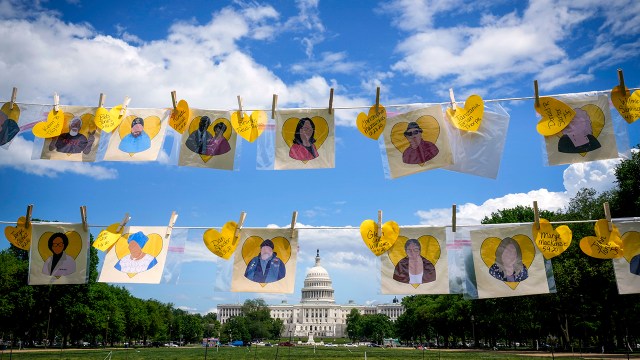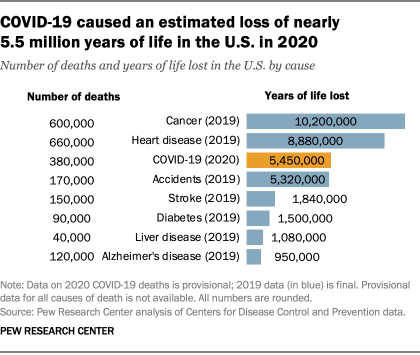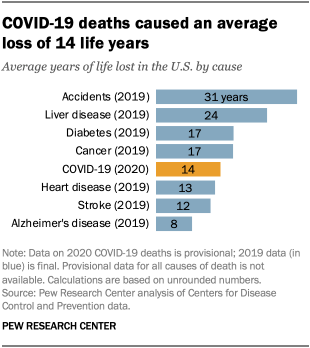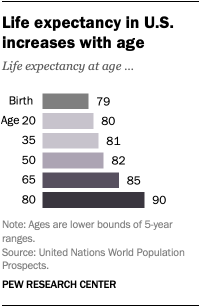
About 600,000 Americans have died of COVID-19 since the coronavirus outbreak began. But behind that huge figure is a more nuanced one that brings the human toll of the virus into even sharper relief.
In addition to the overall number of deaths from a given cause, researchers can estimate the number of “life years” lost due to it – a statistic that takes life expectancy into account. For example, if a person with a life expectancy of 80 dies at age 50, they are estimated to have lost 30 years of life. Examining this statistic underscores the extent to which the virus has cut Americans’ lives short.
In 2020 alone, the coronavirus was responsible for about 380,000 deaths and roughly 5.5 million years of lost life in the United States, according to a Pew Research Center analysis of provisional data from the Centers for Disease Control and Prevention. That number of life years lost is more than the number lost in a typical calendar year to all accidents combined – including traffic accidents, drownings, firearm accidents, drug overdoses and other poisonings – and more than triple the number of life years lost in a normal calendar year due to liver disease or diabetes.
(This analysis compares provisional 2020 data for coronavirus deaths with final 2019 data for all other causes of death. We took this approach for several reasons: Only provisional data is currently available for COVID-19 deaths in 2020; detailed provisional data is not currently available for all other causes of death in 2020; and the pandemic affected mortality patterns for non-coronavirus causes in 2020, too. That makes 2019 a suitable comparison point for the typical number of deaths from various causes in a given year. For more about the methodology of this analysis, read “How we did this.”)
This analysis examines years of life lost due to COVID-19 and various other common causes of death in the United States, based on data from the Centers for Disease Control and Prevention. The analysis relies on provisional 2020 data for coronavirus deaths by age and gender, as well as final 2019 data for other causes of death by age and gender.
We compared life years lost to COVID-19 in 2020 with figures for other causes in 2019 because detailed provisional mortality data on all other causes of death is not yet available for 2020, and because the pandemic affected mortality patterns for non-coronavirus causes in 2020. That makes 2019 a suitable comparison point for the typical number of deaths from various causes in a given year.
It’s important to note that the estimated number of life years lost to COVID-19 in 2020 is not based on a full calendar year of data. The first known U.S. coronavirus death occurred in February 2020. Also, the official tally of U.S. coronavirus deaths in 2020 may be an undercount. As a result, the figures presented in this analysis for life years lost to COVID-19 in 2020 are conservative estimates.
As of publication, provisional data on coronavirus deaths in 2020 was only available by 10-year age group, except for those under age 5 and those 85 and older. When appropriate, 5-year age group life expectancies were averaged and applied to larger age ranges.
The second component of this analysis explores how life expectancy rises with age. It is based on United Nations estimates of life expectancy by age and gender for the current period (2020-2025), which are the same when rounded to integers as the 2015-2020 estimates used to calculate life years lost. While life expectancy decreased in the U.S. due to the coronavirus, this analysis relies on unadjusted data. This is to avoid circular comparisons, and because the recent decrease in life expectancy is likely to be short-term.
The same figures reveal that the average number of life years lost per U.S. coronavirus death in 2020 was 14 years. This is comparable to the average number of years lost per heart disease death in the U.S. in 2019 (13 years) and somewhat lower than the average number of years lost per cancer or diabetes death that year (17 years). But it is far below the average number of years lost per liver disease (24 years) or accidental death (31 years).
Life expectancy increases with age
The large number of life years lost due to COVID-19 in 2020 may not be widely appreciated because people ages 65 and older account for a large majority (approximately 80%) of U.S. coronavirus deaths to date. Some observers have raised the point that the public may believe that these older Americans were nearing the end of their lives anyway.
But life expectancy statistics tell a different story. In fact, life expectancy increases with age. While babies born in the U.S. today can expect to live to be 79, Americans who are 65 today can expect to live to 85, according to the United Nations World Population Prospects. Current 80-year-olds, in turn, can expect to live to an average age of 90.
The pandemic, in other words, has killed many Americans who otherwise might have expected to live for years or even decades longer. A 65-year-old who dies from COVID-19 might ordinarily have expected to live until 85 – a difference of two decades, or roughly a quarter of the average American’s total expected life span at birth.
Average life spans change with age as common causes of death shift over time. By the time a U.S. adult lives to 65, they are unlikely to die from some common causes of death among younger people, such as homicide, pregnancy complications or congenital diseases. At the same time, older Americans are more likely than their younger counterparts to die from causes including heart disease, Alzheimer’s – and now COVID-19.






